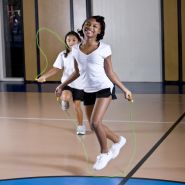In a generation where the prevalence of mental health issues is greater than ever and still increasing, educators must use the opportunities that they are given to support the young people whom they work with. This is especially pertinent for PE teachers, who can use physical activity as a tool to support mental health and well-being among their students. Below are ways in which this could be achieved.
The benefits of physical activity for mental health
Physical activity is proven to be one of the most effective ways of improving mental health and reducing stress and tension with the release of serotonin, the feel-good hormone. Ensure that your lessons are fun and engaging for the groups of students that you have before you, and strive to remove any negative connotations that pupils may have about PE lessons. Consider the use of pupil feedback or pupil voice to tailor the needs and preferences of the students to your lessons, especially in KS4 and KS5 core PE lessons, where pupils may be feeling the stresses of exams, progression routes and their future careers.
Make changing rooms more comfortable
Students may be anxious about the logistics of a PE lesson – especially the changing rooms, changing in front of their peers, or getting themselves dressed in a short timeframe. Support students through these concerns with clear changing room routines. Allow each pupil to choose a space in the changing rooms that becomes ‘theirs’ for the academic year. Allowing them to have their own space, next to familiar peers, could help to relieve anxiety about where they are changing. Also, encourage pupils to change discretely – by sitting down to change their bottom half clothes whilst using their shirt or blazer to cover their upper legs, or by wearing underwear which provides more modesty, such as a longer vest.
Encourage peer-on-peer engagement
Students may also feel anxious about the competitive nature of PE lessons and may be fearful of being put on the spot to demonstrate or perform in front of their peers. This issue takes time to resolve and requires trust between the teacher and pupils to be built. Encourage pupils with high levels of anxiety to work with a peer that they are comfortable with, and ask them to demonstrate or perform for you and their peer whilst the rest of the class continues to work. Offer lots of praise and reassurance, and continue to build this practice up until the student feels comfortable working with a larger or different group of peers.
Physical Education lessons provide opportunities for pupils to improve their mental health, but a ‘one size fits all’ approach rarely works. Speak to the student, and consider speaking to other relevant adults such as parents or the student’s support workers, to devise a plan to enable the student to take part in PE lessons in a way which does not trigger their anxiety. Build up the student’s confidence and trust in you by following the same routines in terms of changing and demonstrations. Small concessions may reap larger rewards in terms of participation and performance.
Using PE Office
PE Office, an online platform dedicated to physical education, can effectively support students with mental health issues and anxiety by providing a range of resources and tools. Its comprehensive curriculum offers a variety of physical activities tailored to different interests and fitness levels, encouraging students to engage in regular physical exercise, a proven stress reliever and mood enhancer.









